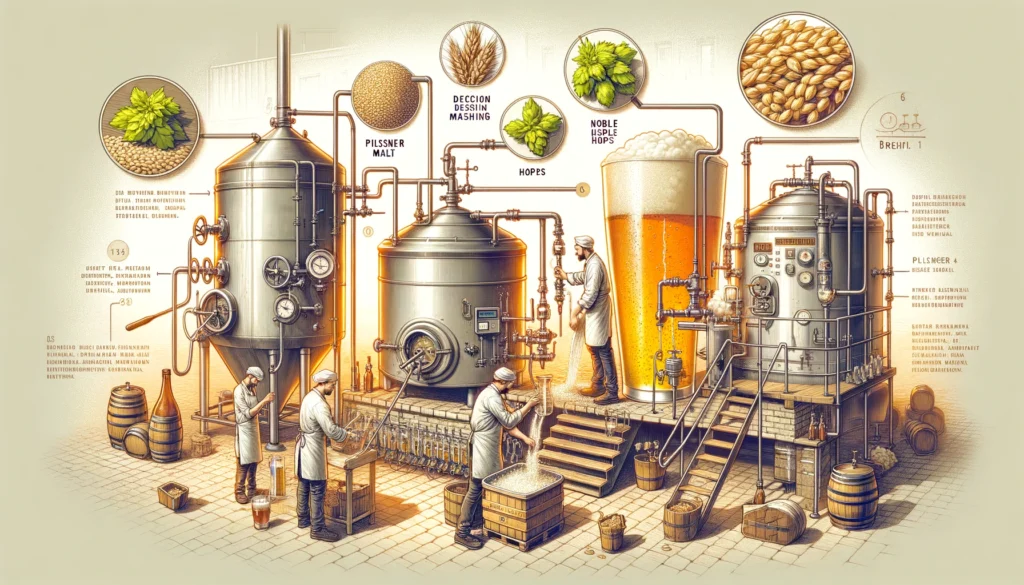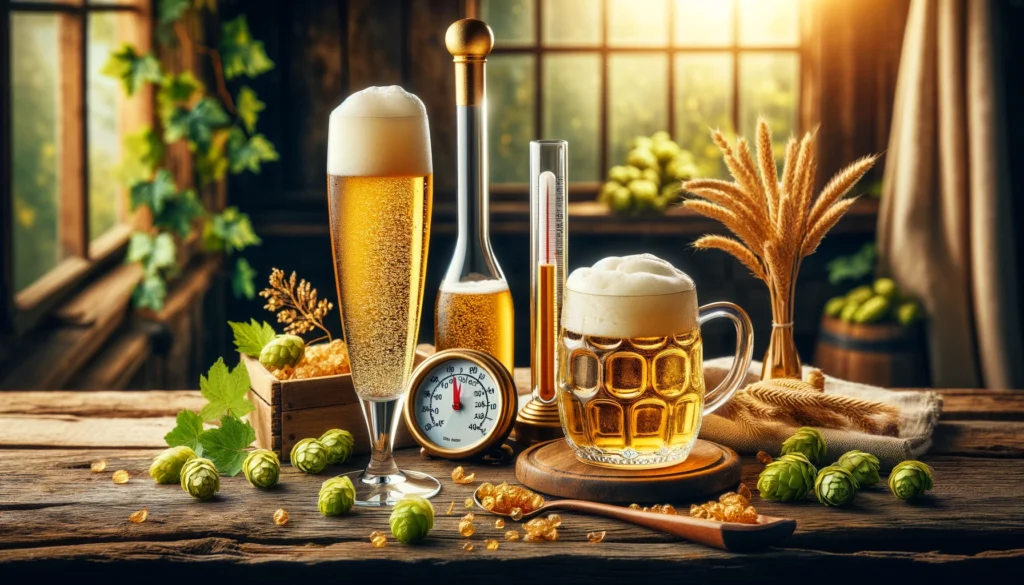Few beer styles capture the spirit of traditional German and European brewing as elegantly as Helles lager. This pale, malty lager is a testament to the ingenuity of Bavarian brewers and their mastery over beer styles that appeals to both tradition-bound purists and modern craft enthusiasts alike. For anyone interested in a refreshing and balanced beer experience, understanding Helles offers a gateway to appreciating the broader category of Lager Beers and German lagers in particular.
This article will dive deep into the beer’s history, brewing process, flavor profile, food pairings, and notable commercial examples.
What is Helles?
Helles Lager is a classic beer from Munich, Germany, celebrated for its smooth, mild flavor and bright, golden color. This beer emerged in the late 19th century as Munich brewers sought to create a lighter alternative to the darker, more bitter beers popular at the time. The result was Helles, which means “bright” or “light” in German, a name that perfectly captures its essence.

History of Helles
The story of Helles begins in Munich during the late 19th century. Created as a response to the popular Czech Pilsner, Helles not only embodied Bavarian brewing traditions but also incorporated broader European brewing techniques while catering to the changing tastes of beer drinkers. It quickly gained popularity, eventually surpassing Munich Dunkel to become a worldwide phenomenon.
Origins
The Helles story starts in Munich, Germany, during the late 19th century. Brewers felt pressure from the growing popularity of Czech Pilsner, a pale lager known for its clarity and hop-forward profile. In response, Munich breweries crafted their pale lager that reflected Bavarian brewing traditions but appealed to Pilsner fans. Thus, the Helles lager was born—meaning “bright” or “pale” in German—and quickly won favor in Bavaria and throughout Europe.
Evolution
Over time, Helles began to overtake Munich Dunkel, the traditional dark lager of Bavaria, due to its bright appearance and refreshing flavor. Its popularity spread beyond Bavaria, becoming a global phenomenon embraced by beer enthusiasts worldwide. Modern craft brewers have also adopted the style, giving it new life with contemporary interpretations and incorporating various European brewing techniques.
Characteristics and Brewing Process
Helles is known for its pale golden color, brilliant clarity, and malt-forward flavor profile, which balances subtle sweetness with floral or spicy noble hops. Brewed with Pilsner malt, noble hops, and lager yeast, Helles undergoes traditional brewing techniques such as decoction mashing and extended lagering to achieve its distinctive flavor and smooth mouthfeel. The ingredients and methods reflect the rich tradition of European Lager Beers.
Appearance
True to its name, Helles exhibits a pale golden hue with brilliant clarity. Its inviting appearance is complemented by a moderate white head that persists as you enjoy this crisp beer.
Aroma and Flavor
A hallmark of the Helles style is its malt-forward aroma and flavor. Expect a distinctive, bready, and subtly sweet profile that balances beautifully with floral or spicy German noble hops. The malt character typically leads with a soft, grainy sweetness, while hop bitterness remains low but present for balance.
Brewing Process: How Helles Lager is Made
The brewing process for Helles involves traditional ingredients like Pilsner malt and noble hops, combined with techniques such as decoction mashing and extended lagering. These methods create a pale, balanced lager that showcases its clean, malt-forward character.
The brewing of Helles involves several critical steps:
- Mashing: The malted barley is mixed with water and heated to extract fermentable sugars.
- Lautering: The mash is strained to separate the wort (liquid) from the grain solids.
- Boiling: The wort is boiled and hops are added for flavor and aroma.
- Fermentation: The cooled wort is transferred to fermentation tanks where yeast is added. It ferments for about one to two weeks.
- Lagering: The beer matures in cold storage for several weeks, enhancing its flavors and clarity.

Ingredients
- Pilsner Malt: The primary grain used in Helles, Pilsner malt gives the beer its distinctive pale golden color and bready, grainy sweetness. The high-quality malt is lightly kilned to preserve its delicate flavor and aroma.
- German Noble Hops: Helles primarily uses noble hop varieties like Hallertau and Saaz, known for their mild bitterness and distinctive floral or spicy aroma. They offer subtle bitterness that balances the malt sweetness without overpowering it.
- Lager Yeast: Traditional lager yeast ferments slowly at low temperatures to achieve a clean, crisp finish. This yeast strain ensures that the malt and hop flavors remain prominent, while ester production is minimized.
- Munich Water Profile: The water used often reflects Munich’s soft water profile, ideal for pale lagers. Soft water helps accentuate the malt sweetness and ensures the beer has a smooth, balanced mouthfeel.
Techniques:
- Decoction Mashing: In this traditional technique, a portion of the mash is boiled separately before being returned to the main mash. This enhances malt flavor and color, giving Helles its characteristic bread-like sweetness.
- Extended Lagering: After primary fermentation, the beer is cold-conditioned (lagered) for several weeks or even months at near-freezing temperatures. This maturation period allows flavors to meld, impurities to settle, and the beer to develop a smooth, refined mouthfeel with brilliant clarity.
- Cold Fermentation: Helles requires slow fermentation at cool temperatures (45-55°F) to minimize ester production and achieve the clean, crisp profile typical of lagers. This process helps maintain the delicate balance of malt and hop flavors.
Style Guidelines
According to the Beer Judge Certification Program (BJCP), the Munich Helles style is recognized for its specific parameters, which define its appearance, bitterness, and alcohol content.

- SRM (Color): 3-5. This pale golden hue, achieved through the use of Pilsner malt, reflects the bright and clear appearance characteristic of this beer.
- IBU (Bitterness): 16-22. The restrained bitterness derives from noble hops like Hallertau or Saaz, providing a balanced bitterness that complements the malt sweetness without overpowering it.
- ABV (Alcohol Content): 4.7-5.4%. Moderate alcohol levels make this an easy-drinking, sessionable beer while maintaining enough body and flavor.
Modern Takes on Helles
Craft brewers today are reviving Helles by either sticking to traditional brewing methods or experimenting with local ingredients. Some incorporate different hops or malts to create a unique twist on the classic style while maintaining its core traits.
Craft Breweries
Modern craft brewers have embraced Helles, sometimes adhering to traditional brewing methods and other times putting a creative spin on the style. Some brewers might experiment with local hops or malts to give the beer a unique character while maintaining the core traits of a classic Helles.
Commercial Examples

For a taste of quality Helles beer, consider these notable examples:
- Weihenstephaner Original Helles: From the world’s oldest brewery.
- Augustiner Lagerbier Hell: A Bavarian staple brewed by Augustiner-Bräu.
- Surly Hell: An American craft twist on the classic style.
Food Pairings with Helles lager
Helles lager pairs exceptionally well with various dishes due to its balanced flavor profile.
Traditional Pairings
Bratwurst, pretzels, schnitzel, and other Bavarian specialties are classic partners. The malt sweetness complements the savory and slightly spicy notes of bratwurst and the saltiness of pretzels, while the clean, crisp finish refreshes the palate.
Globally Inspired Pairings
Helles’s malt-forward flavor also works harmoniously with spicy Asian cuisine, like Szechuan or Thai dishes, where the beer’s subtle sweetness mellows the heat. For lighter fare, grilled seafood, like shrimp or white fish, pairs perfectly with Helles’s delicate bitterness and subtle hop character.
Comparison with Other Beers
Helles stands distinct from other German lagers such as Pilsner and Dunkel. While Pilsners are more hop-forward and bitter, Helles offers a smoother and maltier taste. Compared to the darker and richer Dunkel, Helles is lighter both in color and in taste, catering to those who prefer a crisper beer.
Serving Advice: Enjoying Helles Lager
Serve Helles chilled but not too cold, ideally in a traditional tall glass or a mug to appreciate its color and aroma fully.
FAQs About Helles Lager
What distinguishes Helles Lager from other beers?
Helles is lighter in taste and color compared to other German beers, focusing on a balanced malt flavor with minimal hop bitterness.
Where is Helles Lager brewed?
Originally from Munich, Germany, Helles Lager is now brewed by many breweries around the world, adhering to the traditional recipes and methods.
What foods pair well with Helles Lager?
Traditional Bavarian dishes like pretzels, Weisswurst (white sausage), and potato salads enhance the beer’s mild flavors.
How should Helles Lager be stored?
Keep it in a cool, dark place to maintain its quality and freshness until serving.
Serving Suggestions
- Glassware: Flute or mug, as the tall shape enhances the beer’s effervescence while showcasing its brilliant clarity.
- Temperature: 45-50°F ensures Helles is crisp and refreshing, with its malt and hop flavors well-balanced.

Conclusion
Helles lager exemplifies the precision and craftsmanship of German and European brewing, showcasing a balance between malt sweetness and hop bitterness. This combination makes it versatile and enjoyable for both beer enthusiasts and casual sippers alike. Its pale golden color, clean finish, and refreshing character embody the tradition and innovation of Bavarian and European Lager Beers.
Want to know more about Beer? Here are more articles:
- Understanding Beer Styles: From Pilsners to Stouts
- How Beer is Made: From Ingredients to Fermentation
Harold Desir is a seasoned beer enthusiast and expert, with over a decade of experience exploring the world of craft beers and brewing techniques. His deep knowledge of beer styles, brewing processes, and industry trends makes him a trusted voice in the beer community. Harold's passion for all things beer is evident in his engaging and informative blog posts, where he shares:
Guides & How-Tos: Learn the art of tasting, mixing, and pairing alcohol like a pro.
Exploration of Types: From whiskey and wine to craft beer and cocktails, discover the stories, origins, and nuances of every drink.
Top Lists & Recommendations: Find the best bottles, must-try brands, and top trends in the industry.
DIY & Recipes: Step into the role of a mixologist with our easy-to-follow recipes and tips for creating the perfect drink at home.
Educational Content: Understand the history, production processes, and cultural significance of your favorite spirits and brews.

